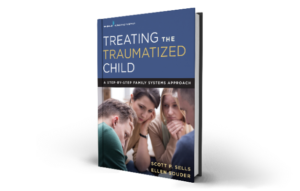Which Came First, the Chicken or the Egg?
The chicken-and-egg expression refers to situations in which it is unknown what happened first, or what situation caused the other.
In trauma treatment, a critical chicken-or-the-egg decision occurs after the diagnostic assessment. Trauma therapists must choose to begin with one of the following goals for therapy:
- Stabilize extreme symptoms (i.e., parent-child conflict, extreme acting out child behaviors, or safety issues such as self-harm, drug abuse, bullying), or
- Active trauma treatment (i.e., unresolved grief, abandonment, family secrets, anxiety, lack of nurturance, anxiety, etc.).
A Case Study
Thirteen-year-old Max was referred to FST| Family Systems Trauma treatment due to extreme symptoms of disrespect, aggression, and running away. After the initial diagnostic session, using the FST techniques of the Stress Chart and Seed Tree Diagram, we determined that the problems were the direct result of the traumatic event (the father’s recent death from cancer) or that they were present prior to the trauma but got much worse as the result the father’s death.
Based on these findings, we had to make an important tactical decision, do we first (a) stabilize Max’s extreme symptoms of disrespect, aggression, and running through interventions such as a behavioral contract or do we use (b) active trauma treatment around the grief through interventions such as grief counseling.
I like to compare this chicken-or-the-egg decision to the urgent decisions emergency room doctors must make when presented a bleeding, bullet-wound patient. The doctor must quickly decide what to do first: stop the bleeding or remove the bullet? The wrong decision could cost the patient his or her life.
The Wrong Decision Can Cause Premature Termination or Worse
Like the ER doctor, the outcome of family trauma treatment often rests on which direction a FST therapist chooses for treatment goals. A wrong decision may have far reaching implications:
- Future sessions may lead to a stuck case or a high likelihood of premature termination.
- Therapists and families may attribute inaccurate causation to treatment failure. For example, if the child or family is not responding to the treatment, the family or therapist might conclude that the child or family is untreatable, resistant, or unmotivated. Instead, the reality is that the wrong treatment was chosen.
My Experience with Choosing the Wrong Treatment
In my case consultation with 16-year-old Lucy and her family, I choose the pathway of active trauma treatment first. As a result of this decision, I initiated a Kill the Spider Trauma Playbook to initiate emotional abandonment trauma healing through hugs between Lucy and her family. The first time the parents tried to hug Lucy, she responded with disrespect, the parents became angry and shut down. Based upon her reaction, the family mistakenly thought Lucy was untreatable and immediately terminated treatment.
In reality, the treatment failure was my fault. This family needed stabilization first before active trauma treatment and not the other way around. Read more about this case here: Failing Forward: Stabilization Before Trauma Playbooks.
Three Rules of Thumb to Help Decide Stabilization or Active Trauma Work

Table 1 illustrates the three rules of thumb we use at the Family Trauma Institute and within the FST treatment model to make the important tactical decision of stabilization or active wound work first. Chapter Five of Treating the Traumatized Child: A Step-by-Step Family Systems Approach outlines the detailed steps of when and how to implement these three rules of thumb along with case examples.
Table 1: Three Rules of Thumb to Help Decide Stabilization or Active Wound Work
Three Rules of Thumb: Stabilization or Active Trauma
Rule of Thumb #1: Chronicity, Bitterness, and Burn Out Levels
- Are the behaviors extreme and happen almost every day or at least once a week? (i.e. aggression, extreme disrespect, running away, alcohol or drug use, self- harm, suicidal ideation, refusal to attend school, etc.)
- Are the parents or caregivers extremely burnt out and overwhelmed?
- Are the parents or caregivers extremely angry, bitter, or resentful toward their child?
Recommendation: If “YES” to all 3 Questions: Stabilization First
Rule of Thumb #2: Timing or Onset of the Child’s Problem Symptoms
- Were the problem behaviors with the child or adolescent present before the wounds occurred and simply got worse after the traumatic event?
- OR did they only emerge after the trauma took place?
Recommendation: Stabilization First if “YES” to Question #1 and Active Trauma Work First if “YES” to Question #2
Rule of Thumb #3: Examine the Trauma Seeds (Wounds, Physical
or Impairment, and Primal Needs)
- Were the child or adolescent’s problem symptoms reported by family members and confirmed by the PLL therapist as one of the three trauma seeds (unhealed wounds, mental or physical impairment, or unmet primal needs) and not the misuse of power seed?
Recommendation: Direct Trauma or Wound Work First
Rule of Thumb #1: Chronicity, Bitterness, and Burnout Levels
Look carefully at the questions presented in Table 1. If you answer “yes” to all three questions, choose stabilization prior to direct wound work. The reason for this choice is that parents often require respite in the form of stabilization to reduce interactional trauma that causes chaos and constant fighting within the family.
Trauma cannot heal in a home environment that is toxic or filled with constant conflict or confrontation between parent and child or parent and parent. It is analogous to constantly picking off a scab every time the wound begins to heal. The wound never heals. Unless the interactional trauma is stopped first, active trauma work cannot begin. Parents and caregivers who often are either burnt out or bitter, must see experience success or achieve some measure of stabilization before having the confidence and trust to move forward with direct trauma work.
Rule of Thumb #2: Timing or Onset of the Child’s Problem Symptoms
This is by far one of the most important rules of thumb. It is critical that you always ask your clients:
“Did the current problems with your child or adolescent happen before the traumatic event and got worse afterward, or did the problems only appear after the trauma?
If the former is true, start with stabilization. This is because most likely the hierarchical structure before and after the traumatic event remains the same: The child is in charge of the household, instead of the parent or caregiver. When a family has an upside-down hierarchy, the FST therapist must first restructure and stabilize the hierarchy using behavioral contracts to have any chance for trauma success. However, if the child’s problem symptoms only occurred after the traumatic event, then active trauma treatment is the best approach.
Rule of Thumb #3: Examine the Trauma Seeds (Wounds, Impairment, and Primal Needs)
Using the FST Model, the Seed Tree Diagram technique identifies toxic seeds and undercurrents that are directly correlated with stabilization (i.e., misuse of power) and active trauma work (i.e., unhealed wound, mental or physical impairment and unmet primal needs). If either the family or FST therapist identifies the cause of the child’s problems as the misuse of power, stabilization is immediately identified. This is because the hierarchy between parent and child must be realigned and stabilized using structural family therapy principles. However, if the family or FST therapist identifies the seeds of unhealed wounds, mental or physical impairment, or unmet primal needs, active trauma treatment is immediately addressed using directives or FST Trauma Playbooks based upon strategic family therapy principles.
About the author
Scott P. Sells, PhD, MSW, LCSW, LMFT, is the author of three books, Treating the Tough Adolescent: A Family-Based, Step-by-Step Guide (1998), Parenting Your Out-of-Control Teenager: 7 Steps to Reestablish Authority and Reclaim Love (2001), and Treating the Traumatized Child: A Step-by-Step Family Systems Approach (2017). He can be contacted at spsells@familytrauma.com or through LinkedIn.

